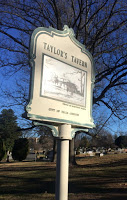U.S. military aviation got its start near Seven Corners
 |
| Taylor’s Tavern [Library of Congress] |
By Mark Kawar, editor of the West of Falls Church blog. This article is part of that blog’s series on local history.
When you think
of Seven Corners, do you think of traffic jams? Strip centers? Redevelopment plans? What about the history
of military aviation?
of Seven Corners, do you think of traffic jams? Strip centers? Redevelopment plans? What about the history
of military aviation?
In a
roundabout way, the U.S. Air Force got its start just behind Koons Ford on
Route 7 in Seven Corners. Here’s the short version of the story:
roundabout way, the U.S. Air Force got its start just behind Koons Ford on
Route 7 in Seven Corners. Here’s the short version of the story:
In May 1861,
Virginia seceded from the Union. Federal forces responded the next day by
crossing the Potomac River and occupying parts of Arlington and Alexandria. For
the next few months, Union and Confederate troops skirmished in the area,
including around Falls Church.
 Meanwhile, a
Meanwhile, ascientist and early experimenter with balloons, Thaddeus S.C. Lowe, was meeting
with President Abraham Lincoln to pitch a plan to use gas-filled balloons to
observe Confederate forces, as the French had done in their war with Prussia
several decades earlier. Lowe won Lincoln’s support after conducting a
demonstration in June for the president in which he sent a telegraph message
to the White House from a balloon 500 feet in the air, tethered across the
street.
With Lincoln’s
support, Lowe proceeded to fill a balloon with helium at the Washington
Gas Company – he didn’t have a good way of transporting helium or making
it near the front – and a team of 15 soldiers took two days to walk it out
to Falls Church.
support, Lowe proceeded to fill a balloon with helium at the Washington
Gas Company – he didn’t have a good way of transporting helium or making
it near the front – and a team of 15 soldiers took two days to walk it out
to Falls Church.
On June 24,
1861, Lowe made several tethered ascents from Seven Corners, near the former Taylor’s Tavern. He chose the site because it was a high point near the edge
of the Union lines.
1861, Lowe made several tethered ascents from Seven Corners, near the former Taylor’s Tavern. He chose the site because it was a high point near the edge
of the Union lines.
According
to the Falls Church Village Preservation and Improvement Society, “They confirmed that Confederate troops were in the Fairfax
Court House but not in threatening force.” This was the first use of an
aircraft in American military history.
to the Falls Church Village Preservation and Improvement Society, “They confirmed that Confederate troops were in the Fairfax
Court House but not in threatening force.” This was the first use of an
aircraft in American military history.
Lowe was going
to move west to assist with the coming first battle of Bull Run, but he had
several balloon accidents and abandoned the plan. After the battle,
Lincoln named Lowe the nation’s “Chief Aeronaut” and put him in charge of the
newly formed Union Army Balloon Corps, which provided
reconnaissance for the Union at several battles across Virginia. The
Confederates later countered with a balloon corps of their own.
to move west to assist with the coming first battle of Bull Run, but he had
several balloon accidents and abandoned the plan. After the battle,
Lincoln named Lowe the nation’s “Chief Aeronaut” and put him in charge of the
newly formed Union Army Balloon Corps, which provided
reconnaissance for the Union at several battles across Virginia. The
Confederates later countered with a balloon corps of their own.
The site of this
first U.S. military aviation is commemorated today with a small plaque on N. Roosevelt
Street (photo above) next to the Oakwood Cemetery.
first U.S. military aviation is commemorated today with a small plaque on N. Roosevelt
Street (photo above) next to the Oakwood Cemetery.
The tavern was
– and the historical marker is – located a few hundred feet inside the City of
Falls Church. But a balloon several hundred feet in the air would have
moved around a bit, so there’s a good chance it crossed the county line, and I
feel quite comfortable claiming this historical event for Fairfax County’s
history, too.
– and the historical marker is – located a few hundred feet inside the City of
Falls Church. But a balloon several hundred feet in the air would have
moved around a bit, so there’s a good chance it crossed the county line, and I
feel quite comfortable claiming this historical event for Fairfax County’s
history, too.


Very interesting; thank you!
The balloon was actually filled with hydrogen. Helium was not discovered until after the civil war.
Lowe also developed portable hydrogen gas generators that used sulfuric acid and iron filings.
Great post, thanks!